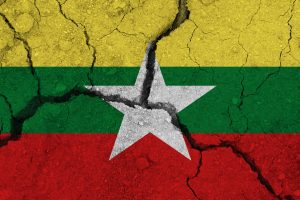An alliance of ethnic armed groups in Myanmar has agreed to extend a ceasefire with the junta in northern Shan State after “pressure” from China, nearly four weeks after the collapse of a China-brokered ceasefire.
In a report on Saturday, the AFP news agency quoted a leader from the Ta’ang National Liberation Army (TNLA) as saying that the ceasefire, which the Alliance unilaterally declared during July 14-18, had been extended until July 31. The representative from the TNLA, one of the three armed groups that make up the Three Brotherhood Alliance, said that this was agreed at the urging of the Chinese government.
“China put a lot of pressure on us to have a ceasefire immediately,” the TNLA leader told the news agency. “Therefore, we have to do it as we can’t avoid it.”
The extension of the ceasefire came after the collapse in late June of a more substantial China-brokered ceasefire, which was agreed in Kunming in January. The TNLA and its Alliance partner, the Myanmar National Democratic Alliance Army (MNDAA), launched attacks on junta positions in northern Shan State and in the northern part of Mandalay Region. The TNLA claimed that the Myanmar military had broken the January ceasefire by launching attacks on the resistance-held territory.
A particular focus has been Lashio, the largest town in northern Shan State and the home of the Myanmar military’s North Eastern Regional Command. But the TNLA, MNDAA, and allied People’s Defense Forces (PDFs) opposed to military rule have also launched attacks and seized considerable territory in Shan State’s Kyaukme, Nawnghkio, and Mongmit townships and Madaya, Singu, and Mogok townships of Mandalay Region. According to The Irrawaddy, anti-regime forces have now taken control of Kyaukme and Nawnghkio towns, which sit on the main highway connecting Mandalay to the Chinese border. They have also taken a large part of Mogok, a ruby-mining center about 200 kilometers northeast of Mandalay.
The attacks marked the second phase of Operation 1027, which the Alliance launched in October of last year. The offensive made rapid gains against the demoralized and thinly provisioned forces of the Myanmar military. By the time China managed to broker a ceasefire between the groups in Kunming in January, the three armies had seized a large swathe of territory in northern Shan State, including several hundred outposts, around 20 towns, and control of several important border crossings with China. The Arakan Army, the third member of the Three Brotherhood Alliance, has also made large territorial gains in Rakhine State, in western Myanmar; it now claims to exercise primary control over more than half of the state’s 17 townships.
As AFP reports, the new agreement does not cover Mandalay Region, where members of the alliance and other anti-junta forces continue to press their advantage against the Myanmar military. On Saturday, the Mandalay People’s Defense Force (PDF) claimed to have taken complete control of Singu Township in northern Mandalay Region after around three weeks of fighting. One observer said in a post on X that with the fall of Singu, there was now “uninterrupted resistance control” from the Chinese border to the Irrawaddy River.
According to The Irrawaddy, the Mandalay PDF and other resistance groups are attacking regime targets in Madaya Township, adjacent to Mandalay, Myanmar’s second-largest city, and have seized nearly 30 junta bases, including an Air Defense Battalion headquarters. The continued advance of anti-regime forces has forced the Myanmar Navy to deploy warships in the Irrawaddy River around Mandalay.
The extension of the ceasefire in northern Shan State is the latest evidence that China is less than enthused with the resumption of fighting along its border with Myanmar. It is widely believed that China stood aside and allowed the first phase of Operation 1027 to proceed, largely due to the junta’s reluctance to clamp down on transnational criminal operations in areas of the border region controlled by its allies. But Beijing likely fears the impacts of the extension of the fighting further south, viewing it as a threat to the stability of the border region as a whole. There have also been reports that the Chinese authorities cut off power and internet supplies to the MNDAA-controlled territory in northern Shan State, and closed the region’s border with China, as a way of showing its displeasure after the group launched its assault on Lashio at the start of this month.
Whether this temporary ceasefire is a prelude to a more substantial and lasting settlement remains to be seen. China’s ties to the armed groups based along its border give it a degree of influence in northern Myanmar and, as the above-cited quote from the TNLA official makes clear, the region’s ethnic armed groups cannot afford to ignore Beijing’s views. At the same time, China’s influence to dictate events in Shan State remains limited at a time of heated contestation between the Myanmar military and its many opponents.
With long-sought political goals now seemingly within reach, groups like TNLA and MNDAA are unlikely indefinitely to desist.

































